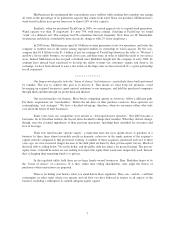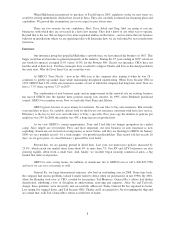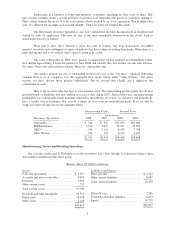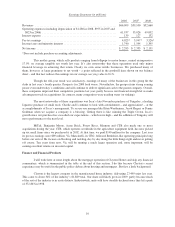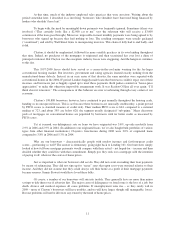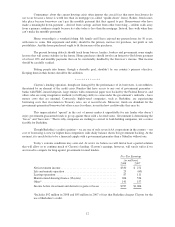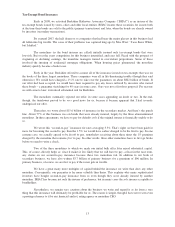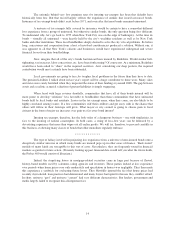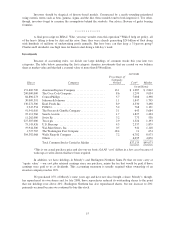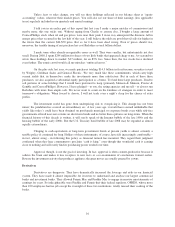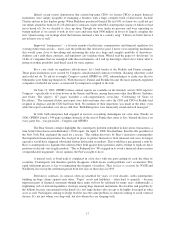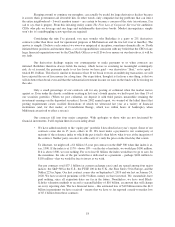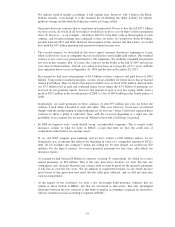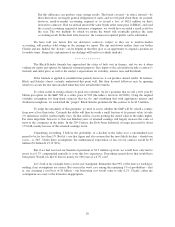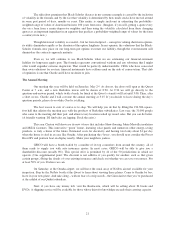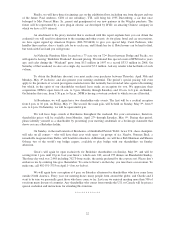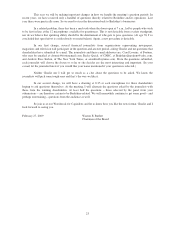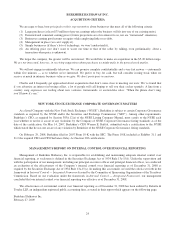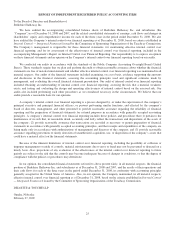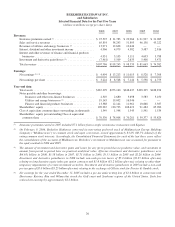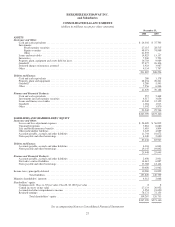Berkshire Hathaway 2008 Annual Report Download - page 19
Download and view the complete annual report
Please find page 19 of the 2008 Berkshire Hathaway annual report below. You can navigate through the pages in the report by either clicking on the pages listed below, or by using the keyword search tool below to find specific information within the annual report.Indeed, recent events demonstrate that certain big-name CEOs (or former CEOs) at major financial
institutions were simply incapable of managing a business with a huge, complex book of derivatives. Include
Charlie and me in this hapless group: When Berkshire purchased General Re in 1998, we knew we could not get
our minds around its book of 23,218 derivatives contracts, made with 884 counterparties (many of which we had
never heard of). So we decided to close up shop. Though we were under no pressure and were operating in
benign markets as we exited, it took us five years and more than $400 million in losses to largely complete the
task. Upon leaving, our feelings about the business mirrored a line in a country song: “I liked you better before I
got to know you so well.”
Improved “transparency” – a favorite remedy of politicians, commentators and financial regulators for
averting future train wrecks – won’t cure the problems that derivatives pose. I know of no reporting mechanism
that would come close to describing and measuring the risks in a huge and complex portfolio of derivatives.
Auditors can’t audit these contracts, and regulators can’t regulate them. When I read the pages of “disclosure” in
10-Ks of companies that are entangled with these instruments, all I end up knowing is that I don’t know what is
going on in their portfolios (and then I reach for some aspirin).
For a case study on regulatory effectiveness, let’s look harder at the Freddie and Fannie example.
These giant institutions were created by Congress, which retained control over them, dictating what they could
and could not do. To aid its oversight, Congress created OFHEO in 1992, admonishing it to make sure the two
behemoths were behaving themselves. With that move, Fannie and Freddie became the most intensely-regulated
companies of which I am aware, as measured by manpower assigned to the task.
On June 15, 2003, OFHEO (whose annual reports are available on the Internet) sent its 2002 report to
Congress – specifically to its four bosses in the Senate and House, among them none other than Messrs. Sarbanes
and Oxley. The report’s 127 pages included a self-congratulatory cover-line: “Celebrating 10 Years of
Excellence.” The transmittal letter and report were delivered nine days after the CEO and CFO of Freddie had
resigned in disgrace and the COO had been fired. No mention of their departures was made in the letter, even
while the report concluded, as it always did, that “Both Enterprises were financially sound and well managed.”
In truth, both enterprises had engaged in massive accounting shenanigans for some time. Finally, in
2006, OFHEO issued a 340-page scathing chronicle of the sins of Fannie that, more or less, blamed the fiasco on
every party but – you guessed it – Congress and OFHEO.
The Bear Stearns collapse highlights the counterparty problem embedded in derivatives transactions, a
time bomb I first discussed in Berkshire’s 2002 report. On April 3, 2008, Tim Geithner, then the able president of
the New York Fed, explained the need for a rescue: “The sudden discovery by Bear’s derivative counterparties
that important financial positions they had put in place to protect themselves from financial risk were no longer
operative would have triggered substantial further dislocation in markets. This would have precipitated a rush by
Bear’s counterparties to liquidate the collateral they held against those positions and to attempt to replicate those
positions in already very fragile markets.” This is Fedspeak for “We stepped in to avoid a financial chain reaction
of unpredictable magnitude.” In my opinion, the Fed was right to do so.
A normal stock or bond trade is completed in a few days with one party getting its cash, the other its
securities. Counterparty risk therefore quickly disappears, which means credit problems can’t accumulate. This
rapid settlement process is key to maintaining the integrity of markets. That, in fact, is a reason for NYSE and
NASDAQ shortening the settlement period from five days to three days in 1995.
Derivatives contracts, in contrast, often go unsettled for years, or even decades, with counterparties
building up huge claims against each other. “Paper” assets and liabilities – often hard to quantify – become
important parts of financial statements though these items will not be validated for many years. Additionally, a
frightening web of mutual dependence develops among huge financial institutions. Receivables and payables by
the billions become concentrated in the hands of a few large dealers who are apt to be highly-leveraged in other
ways as well. Participants seeking to dodge troubles face the same problem as someone seeking to avoid venereal
disease: It’s not just whom you sleep with, but also whom they are sleeping with.
17


